The British cold war recce tank
The Scimitar (from the famous Saracen curved blade) was an early CRV(T) or Combat Vehicle Reconnaissance (Tracked) as designated, which comprised 8 models for which Alvis was awarded in 1988 the Life Extension Programme. It shared its chassis and most components with the Scorpion. The turret, also similar to the Scorpion's was in reality shared with the Fox wheeled armored reconnaissance vehicle, housing the high velocity 30 mm L21 RARDEN cannon. The Scimitar entered service in 1971, one year after the Scorpion, but it is still in service today. So far 466 were built by Alvis from Coventry, including some 141 for Belgium.Design
As stated above, the Scimitar was essentially similar to the Scorpion, but for the main cannon. The hull was made of welded rolled homogeneous armor plates of hardened aluminum alloy, with the driver at the front-left, and had a rounded nose and well-sloped glacis plate. Protection is adequate against 12.7 mm heavy machine gun rounds at the front and small arms fire and artillery shell splinters all around. The two other members of the crew take place in the turret, the commander and gunner, each with their own hatch, and a cupola for the commander. Peripheral vision is provided by three large vision devices on the commander's side and gunner's large font turret periscopic sight with passive night vision (also for the driver). There are automatic fire extinguishers in the crew and engine compartments and a collective NBC protection system and in addition later a forced air system to answer CRBN environment threats. For comfort there is also a boiling vessel (BV), to cook and make hot drinks and a toilet. Storage all around on the turret sides, hull sides and rear are generous. For active protection, the turret also received 2 × 4-barrel of smoke grenade dischargers.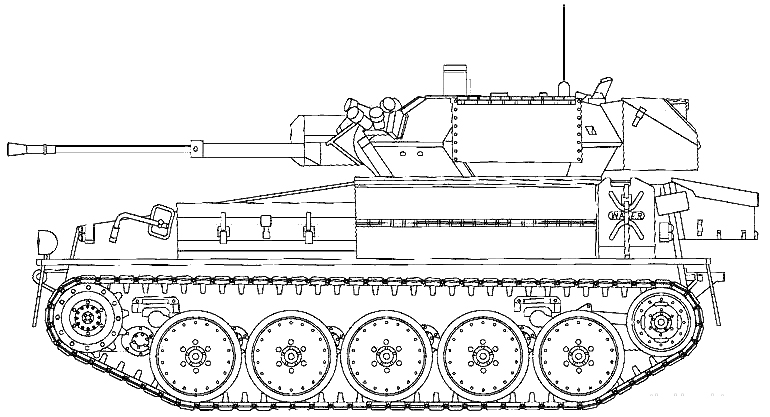
Fv107 Scimitar Blueprint. Notice the absence of side vision devices on the turret.
The armament comprises the main 30 mm L21 RARDEN cannon (elevation/depression +35°/-10°) which is high-velocity, quick-firing (90 rpm) and can fire a large array of projectiles, including the Armour Piercing Discarding Sabot-Tracer (APDS-T), High explosive (HE), Armour-Piercing (AP), High Explosive Incendiary (HEI), and armor-piercing special effects (APSE). In total 165 rounds are carried. In addition, there is the coaxial L37A1 Machine Gun with 2000 rounds including tracers. The main gun is able to disable most wheeled vehicles in service, light tanks, APCs and some IFVs. There is also an optional thermal sight and laser rangefinder.
For mobility it relied on a Jaguar J60 4.2-litre 6-cylinder petrol engine, light and powerful at that time later replaced by a diesel Cummins BTA 5.9 diesel of 190 hp (142 kW) placed on the right. It was slightly lighter than the Scorpion (7.8 vs. 8 tons), and faster at 80 kph vs. 72 kph (50 vs. 45 mph). The transmission was up to the challenge, transferring most of the torque on the external part of the tracks, allowing fast turns, even 360° on the spot, and fast reverse speeds as well.
The range was somewhat inferior (450 vs. 750 km perhaps related to the former gasoline Jaguar). However, both vehicles relied on a similar five relatively large rubber-tires roadwheels independently sprung with torsion bars completed by front sprockets and rear idlers but no return rollers. The Scimitar could be provided with a flotation kit to ford large water barriers, but it can ford up to a depth of 1 meter without preparation. It can also climb a 60% gradient, 35% side slope, or a vertical step 0.5 m high, and gap a trench 2 m wide. Ground pressure was quite low and the vehicle could be air-transportable to any spot by Chinook helicopters.
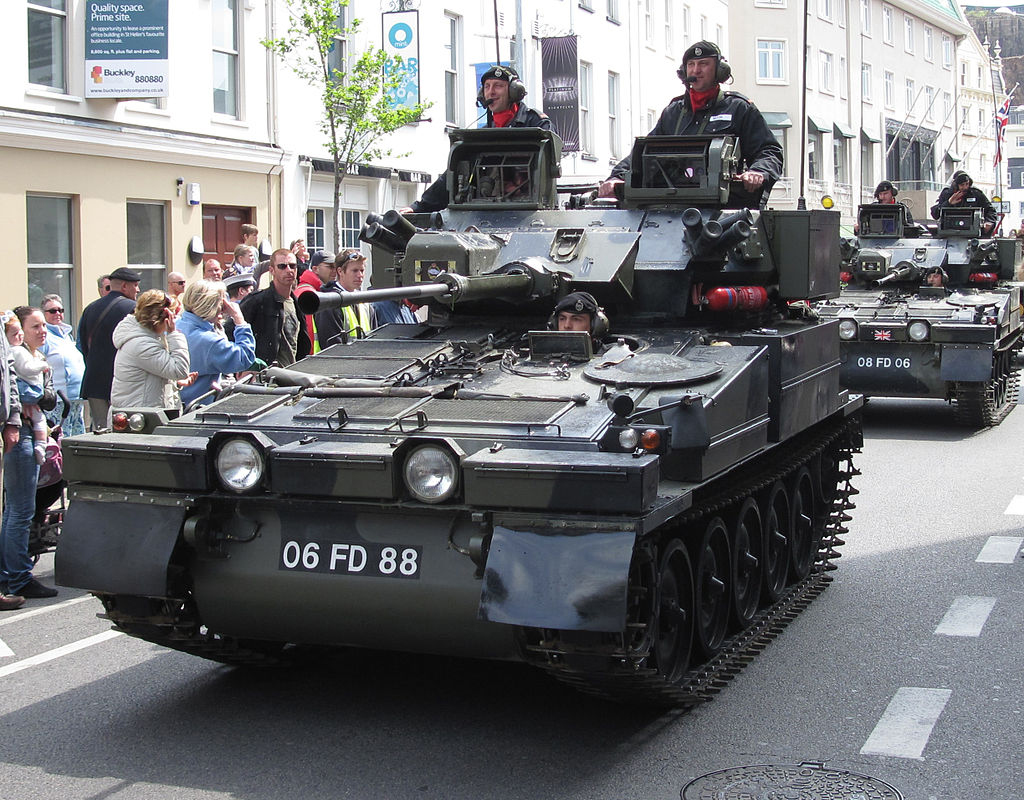 FV107s as the Jersey liberation day, May 2010.
FV107s as the Jersey liberation day, May 2010.Production
Outside the UK, that keep the bulk of the 325 reconnaissance tanks (according to european-defence.co.uk. January 2008) for 429 to 486 in total (even 641 for militaryfactory.com). According to the Ministry of Defence of the Czech Republic, 141 were in service with the Belgian Army until 2004, but Jordan now operates 100 (to 171 according to other sources) a deal from 2009, the tanks were scheduled for retirement and were sold at an estimated unitary cost of $194,175. Nigeria allegedly operated five (unconfirmed) and the Honduras three.The Scimitar in action
First engagement of the Scimitar came with the Blue & Royals (Royal Horse Guards and 1st Dragoons) in the 1982 Falklands War. This was the only armored vehicle in action in the Falklands, where they played a critical role in cornering the Argentine forces in the outskirts of Port Stanley. One was damaged by a mine but was recovered and carried by a Chinook HC.1 helicopter in safety. The crew remains unscathed.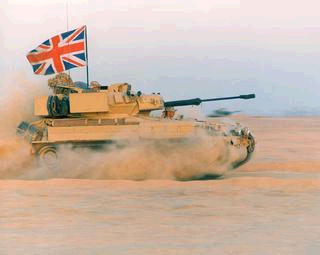 Fv107 in the 1991 Gulf War. It can achieve a top speed of 80 kph on flat, unmatched by most tracked vehicles.
In 1991, Scimitars of the 16th/5th The Queen's Royal Lancers were engaged in the gulf war. At some point, they engaged and destroyed T-62s with their sabot rounds, directly through their frontal armor. On the other hand, one was hit by a T-55 round which just passed through both sides of the thin armor, leaving without any injury. In the 1990s, Scimitars with the UN were deployed in ex-Yugoslavia (Bosnia and Kosovo) for peace-keeping operations.
Fv107 in the 1991 Gulf War. It can achieve a top speed of 80 kph on flat, unmatched by most tracked vehicles.
In 1991, Scimitars of the 16th/5th The Queen's Royal Lancers were engaged in the gulf war. At some point, they engaged and destroyed T-62s with their sabot rounds, directly through their frontal armor. On the other hand, one was hit by a T-55 round which just passed through both sides of the thin armor, leaving without any injury. In the 1990s, Scimitars with the UN were deployed in ex-Yugoslavia (Bosnia and Kosovo) for peace-keeping operations.
In 2003 with the invasion of Iraq, Scimitars were again engaged in the "war on terror". Those of the Queen's Dragoon Guards were engaged in the Battle of Al Faw on March 20–24. By 2010 some received BAR armor to deal with RPGs (see later). In Afghanistan, Scimitars were used as part of the Operation Herrick in the so-called Jackal high-mobility composite troops, providing extra firepower but keeping pace with wheeled vehicles.
The Scimitar, as of Jan. 2016 is used by the five formation reconnaissance regiments of the British Army, each counting three squadrons of 12 Scimitars. The Household Cavalry Regiment has an extra squadron. The Strategic Defence and Security Review in 2010 claimed that some regiments had their Challenger 2 tanks replaced with CVR(T) Scimitars.
However the CRV(T) modernization plan of 2009 saw the Future Rapid Effect System program extending the active life of Scimitars up to 2017, when these vehicles would be replaced by the AJAX. In 2009 modifications included air filtration units, gearbox upgrades, hull alterations and even in 2010 creation of Spartan/Scimitar hybrids ("Up-armoured vehicles begin Afghanistan operations") with BAR armour.
Links
The Scimitar on Wikipedia
Scimitar FV107 specifications |
|
| Dimensions (L-w-h) | 4.80m x 2.18m x 2.1m (15'9" x 7'2" x 6'11" ft.in) |
| Total weight, battle ready | 7.8 tons (15,600 Ibs) |
| Crew | 3 (driver, gunner, commander) |
| Propulsion | Cummins BTA 5.9 diesel 190 hp (142 kW) |
| Suspension | Torsion bars |
| Speed (road) | 80 km/h (50 mph) |
| Range | 450 km (280 mi) |
| Armament | 1x 30mm L21 RARDEN, coax 7.92mm L37A1 MG |
| Armor | Est. 13 mm front, 8 mm sides and rear (0.3-0.5 in) |
| Total production | 486 |
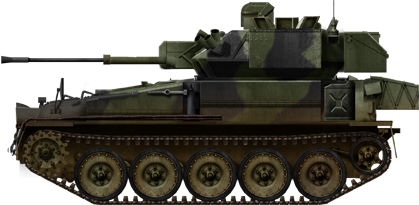
FV107 Scimitar in the original configuration.

Camouflaged Scimitar possibly at the BANFF training grounds.
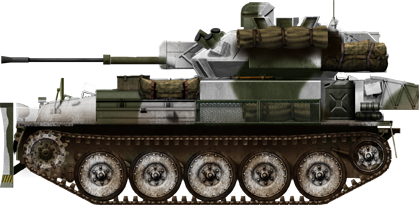
Scimitar with a dozer blade kit and washable winter paint.
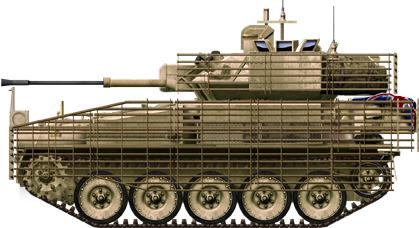
Modernized FV107 Spartan/Scimitar hybrid with BAR armour as of 2010, Iraq.
Gallery
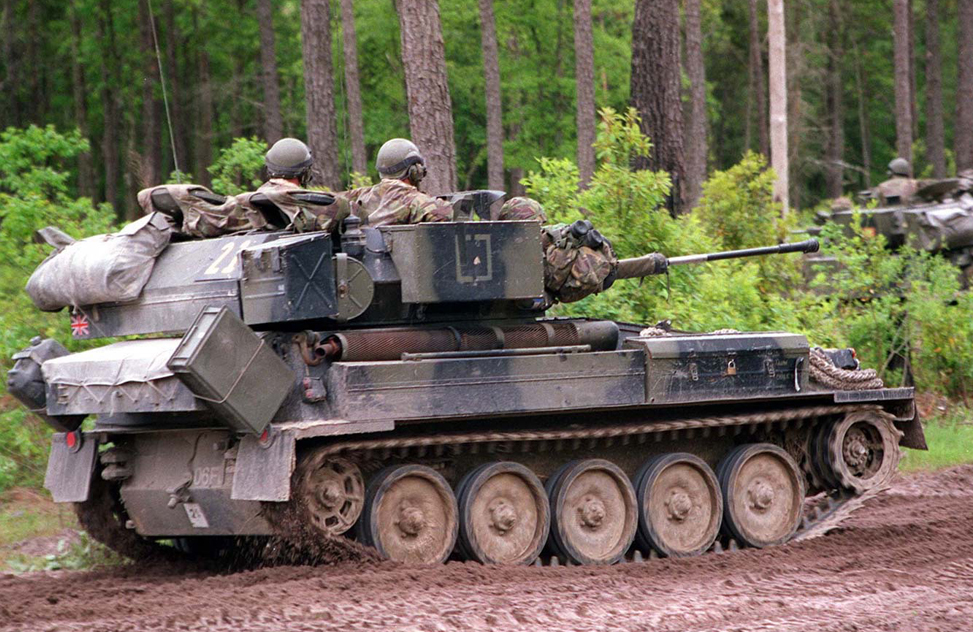
Alvis Scimitar in exercises in the 2000s
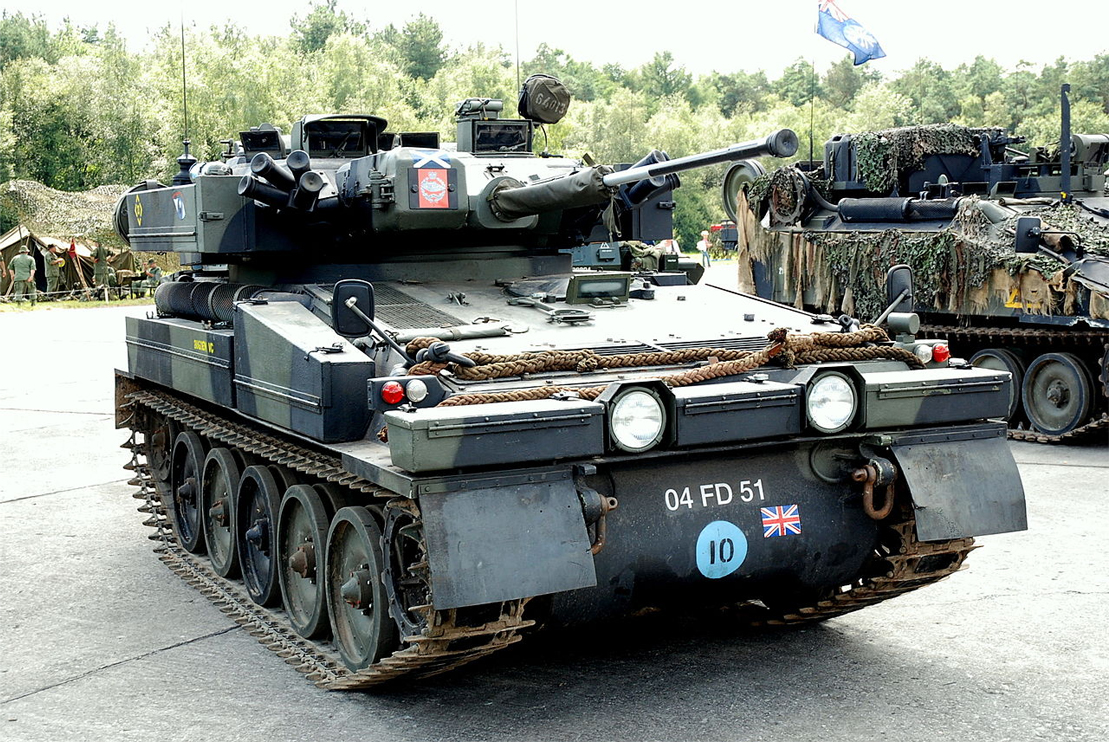
Scimitar and Spartan (background)
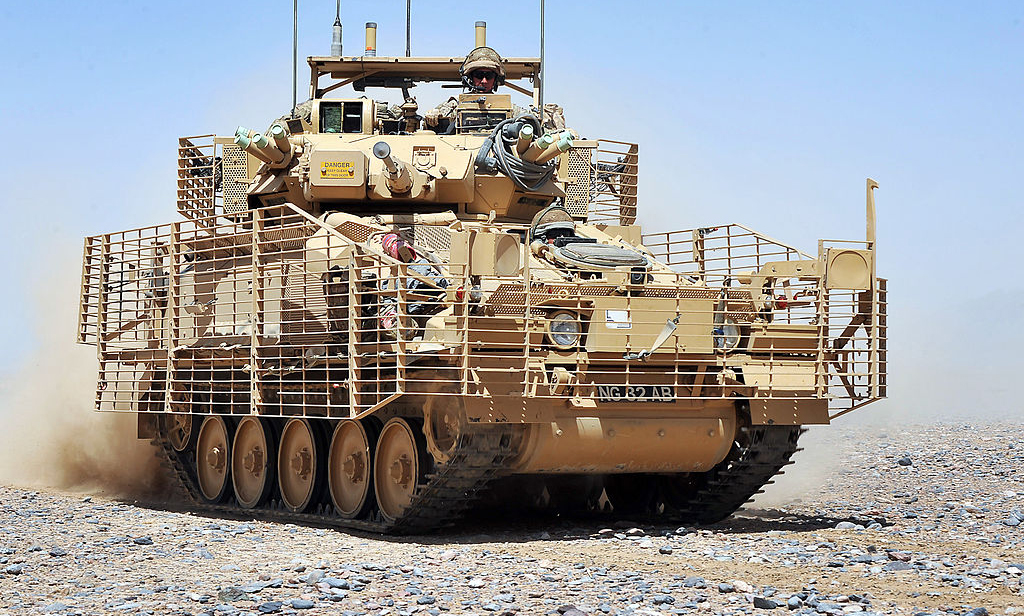
Scimitar in Afghanistan, with BAR armour, 2010
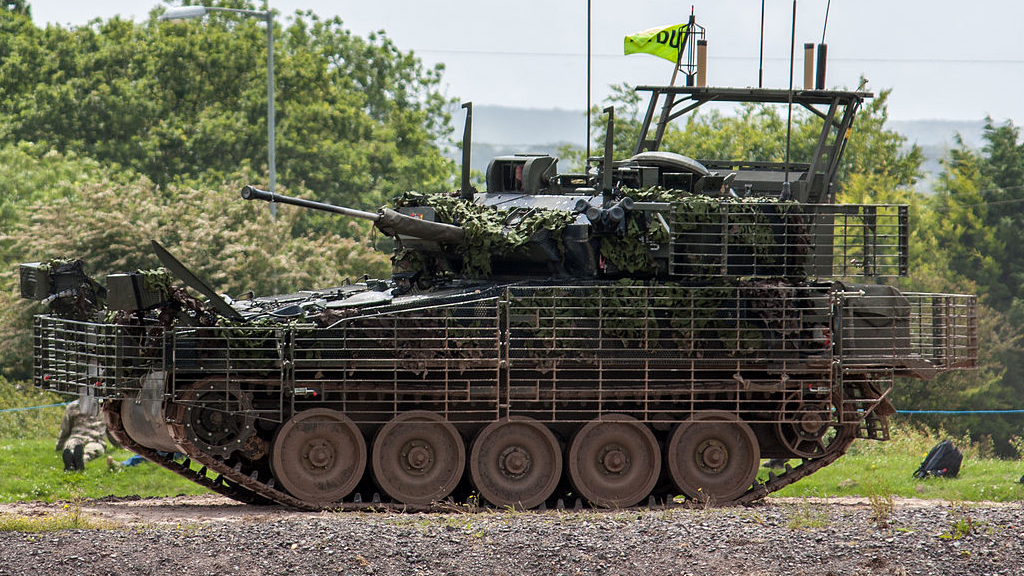
Scimitar with BAR armour and upgraded COM set, new gearbox, hull modifications.
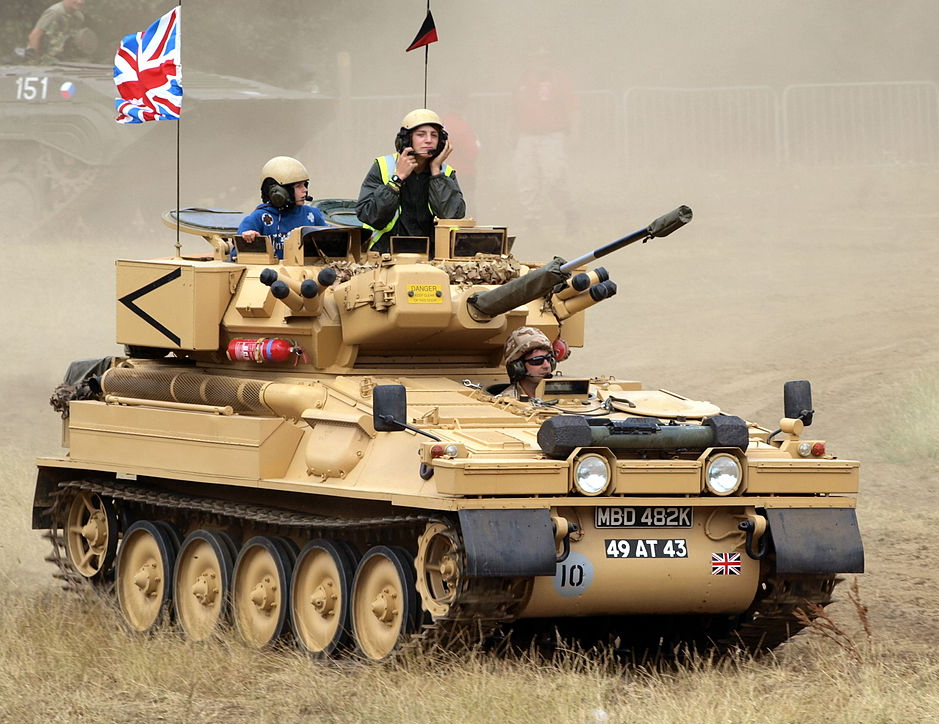
Scimitar of the Gulf War at the summer 2010 Bovington tank parade.

Cold War Tanks


































Cold war tanks posters

Cold War Main Battle Tanks

Cold War Soviet Army
Museums, Movies, Books & Games
The Tanks and Armor in pop culture
Tanks and armored vehicles in general are only really grasped when seen first person: The mass, the scale, it's all there. Explore also the way tanks were covered in the movie industry, in books and in video games.Movies:
Best tanks movie on warhistoryonline.com
On imdb.com
On bestsimilar.com/
miltours.com
liveabout.com/
watchmojo.com
Video Games:
pcgamesn.com
historyhit.com
levvvel.com
vg247.com/best-tank-games
mmobomb.com/
alienwarearena.com

